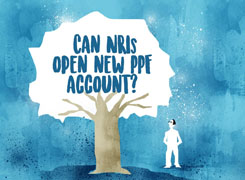Ramalingam Kalirajan |10874 Answers |Ask -Follow
Mutual Funds, Financial Planning Expert - Answered on Jun 10, 2025
He has an MBA in finance from the University of Madras and is a certified financial planner.
He is the director and chief financial planner at Holistic Investment, a Chennai-based firm that offers financial planning and wealth management advice.... more

Prabhu Asked on - Jun 09, 2025 Hi sir, I'm 39 working with MNC with take home 1.4L. Kindly advice 2 thing. Shall I close the loan with PPF and does my investment are on right way. Investment 30L ESOP 30L MF 15L PPF ( matured) 25K yearly in ulip for 20 years stared in 2022. 12K SIP Liabilities 20L home loan ( 9 yr completed) 30K expenses monthly 21K health insurance yrly 40K term insurance yrly
Should I close my home loan using my matured PPF?
Are my investments on the right track?
Let us evaluate both in a detailed and professional manner. We will look at your finances from a full 360-degree view to help you take better decisions.
Present Financial Snapshot
Let us understand your current assets and liabilities first:
Take-home salary: Rs. 1.4 lakh per month
Home loan outstanding: Rs. 20 lakh (9 years completed)
Monthly EMI (assumed): Not mentioned, but likely Rs. 20,000–25,000
Monthly expenses: Rs. 30,000
Health insurance premium: Rs. 21,000 per year
Term insurance premium: Rs. 40,000 per year
SIP: Rs. 12,000 per month
ULIP: Rs. 25,000 per year (started in 2022 for 20 years)
PPF: Rs. 15 lakh (matured)
Mutual funds: Rs. 30 lakh
ESOPs: Rs. 30 lakh
Let us now analyse both your questions step by step.
Should You Close Home Loan Using PPF?
You have completed 9 years of a housing loan.
Only Rs. 20 lakh is left as balance.
PPF has matured and holds Rs. 15 lakh.
Your PPF is a safe and tax-free investment.
You should not use the full amount to close your home loan.
Here is why: Home loan gives tax benefits on both interest and principal.
It also helps you build your credit history.
Your EMI seems comfortable at Rs. 20,000 to Rs. 25,000.
Your net monthly surplus is very good after expenses and SIP.
Do partial prepayment of home loan only.
Use Rs. 5 lakh from PPF to reduce your loan balance.
This reduces your interest burden.
Keep Rs. 10 lakh in PPF for safety and emergencies.
Don’t close full loan now.
If you reduce loan tenure (not EMI), it saves more interest.
This way, you reduce interest and still keep benefits.
Don't touch the rest of PPF.
It can also act as emergency fund in job break, health issue or family need.
Full closure of home loan is not necessary if EMI is manageable.
Should You Continue or Surrender the ULIP?
You are paying Rs. 25,000 per year in a ULIP since 2022.
ULIPs mix insurance and investment in one product.
In the first few years, most of your money goes in charges.
They are very costly, and the returns are unpredictable.
You already have term insurance for pure protection.
ULIP is not needed.
You can surrender this policy immediately.
Reinvest the amount in mutual funds through SIP or STP.
This way, you get better returns with lower costs.
ULIP does not offer flexibility or goal matching.
Mutual funds give transparent performance tracking.
Avoid mixing insurance with investments in future.
Is Your Investment Strategy on the Right Path?
Let’s analyse your current investment portfolio from all sides.
1. Mutual Funds – Rs. 30 lakh
This is a strong amount for your age.
You are running a SIP of Rs. 12,000 monthly.
This shows discipline and long-term thinking.
Try to increase SIP yearly with salary hike.
Aim for Rs. 20,000 to Rs. 25,000 SIP monthly in next 2 years.
Invest in actively managed funds, not index funds.
Index funds only copy the market and don’t give extra return.
Active funds have fund managers to help beat inflation.
Also, avoid direct plan funds if used.
They may look cheaper, but offer zero guidance or review.
Use regular plan via Certified Financial Planner (CFP).
This gives ongoing support, rebalancing, and handholding.
Review your MF portfolio once in 6 months.
Keep mix of large cap, flexi cap and mid cap funds.
Avoid small cap if your goals are short term.
Long-term goals should drive your MF selection.
Keep 1 goal for each MF. Example: Retirement, freedom, child, etc.
This brings clarity and emotional discipline.
2. ESOPs – Rs. 30 lakh
ESOPs can create sudden wealth but are high risk.
They are linked to one company, your employer.
This is called “double risk”.
If your job and stock both go down, you face double pain.
Keep ESOPs within 20% of your total portfolio.
You already have Rs. 30 lakh in ESOP, and Rs. 30 lakh in MFs.
That’s a 50-50 split now.
Start selling some ESOP every year.
Move the money into mutual funds or debt funds.
This reduces risk and adds diversity.
Also, check tax rules before selling ESOPs.
Avoid waiting for maximum price or market timing.
Take money out slowly over 2–3 years.
Don't link your wealth to one company stock.
3. PPF – Rs. 15 lakh (matured)
You have done very well by holding PPF till maturity.
PPF is one of the best low-risk options in India.
Use only part of it for loan prepayment.
Keep balance for emergencies or future needs.
You can also open a new PPF again.
This helps save tax under Section 80C.
Use PPF as a safety cushion, not for aggressive growth.
4. SIP – Rs. 12,000 monthly
SIP is a good habit for wealth creation.
Increase it step by step every year.
Add Rs. 2,000–3,000 more every 6 months.
Your current income allows higher SIP.
But maintain balance between investing, EMI, insurance and life needs.
Insurance Coverage Assessment
1. Health Insurance
You are paying Rs. 21,000 per year.
Check if the cover is at least Rs. 25 lakh floater.
If not, take a super top-up plan.
Health expenses are rising faster than income.
Good insurance protects your savings and wealth.
2. Term Insurance
You are paying Rs. 40,000 yearly.
Ensure cover is 15 to 20 times your annual income.
Your income is Rs. 16.8 lakh yearly (1.4 lakh x 12).
So, term cover should be at least Rs. 3 crore.
If current cover is lower, take an extra policy.
Term plans are cheap and pure protection.
Don't delay increasing your coverage.
Suggestions for Future Financial Growth
Track your net worth every 6 months.
Maintain a monthly budget sheet to manage expenses.
Avoid luxury spending from bonuses or incentives.
Don’t buy any new real estate for investment.
Real estate locks money and gives poor flexibility.
Avoid F&O, crypto, or stock tips from social media.
These look exciting but destroy wealth silently.
Stick to your own goals and asset allocation.
Write your goals on paper – with amount and time.
Example: Rs. 2 crore for retirement by age 55, Rs. 40 lakh for child.
Link each investment to one goal.
This gives emotional connection and purpose.
Stay patient during market ups and downs.
Don’t stop SIPs during market fall. That’s when you get more value.
Meet a Certified Financial Planner every year to review.
Life changes. So should your plan.
Finally
Do not close your entire home loan using PPF.
Do partial prepayment with Rs. 5 lakh only.
Keep Rs. 10 lakh from PPF as emergency buffer.
Surrender your ULIP and shift to mutual funds.
Increase SIP step by step.
Reduce ESOP exposure to avoid risk.
Review term and health insurance coverage immediately.
Maintain goal-based investing using active mutual funds.
Avoid direct and index funds.
Keep meeting Certified Financial Planner every year.
This builds financial freedom, not just wealth.
You are already on a strong path. Just refine it smartly.
Best Regards,
K. Ramalingam, MBA, CFP,
Chief Financial Planner,
www.holisticinvestment.in
https://www.youtube.com/@HolisticInvestment
You may like to see similar questions and answers below
Ramalingam Kalirajan |10874 Answers |Ask -Follow
Mutual Funds, Financial Planning Expert - Answered on Aug 08, 2024
Mayank Chandel |2569 Answers |Ask -Follow
IIT-JEE, NEET-UG, SAT, CLAT, CA, CS Exam Expert - Answered on Dec 08, 2025
Mayank Chandel |2569 Answers |Ask -Follow
IIT-JEE, NEET-UG, SAT, CLAT, CA, CS Exam Expert - Answered on Dec 08, 2025

Mayank Chandel |2569 Answers |Ask -Follow
IIT-JEE, NEET-UG, SAT, CLAT, CA, CS Exam Expert - Answered on Dec 08, 2025
Mayank Chandel |2569 Answers |Ask -Follow
IIT-JEE, NEET-UG, SAT, CLAT, CA, CS Exam Expert - Answered on Dec 08, 2025
Mayank Chandel |2569 Answers |Ask -Follow
IIT-JEE, NEET-UG, SAT, CLAT, CA, CS Exam Expert - Answered on Dec 08, 2025
Anu Krishna |1746 Answers |Ask -Follow
Relationships Expert, Mind Coach - Answered on Dec 08, 2025
Ramalingam Kalirajan |10874 Answers |Ask -Follow
Mutual Funds, Financial Planning Expert - Answered on Dec 08, 2025
Samraat Jadhav |2499 Answers |Ask -Follow
Stock Market Expert - Answered on Dec 08, 2025
Ramalingam Kalirajan |10874 Answers |Ask -Follow
Mutual Funds, Financial Planning Expert - Answered on Dec 08, 2025
Radheshyam Zanwar |6737 Answers |Ask -Follow
MHT-CET, IIT-JEE, NEET-UG Expert - Answered on Dec 08, 2025





















